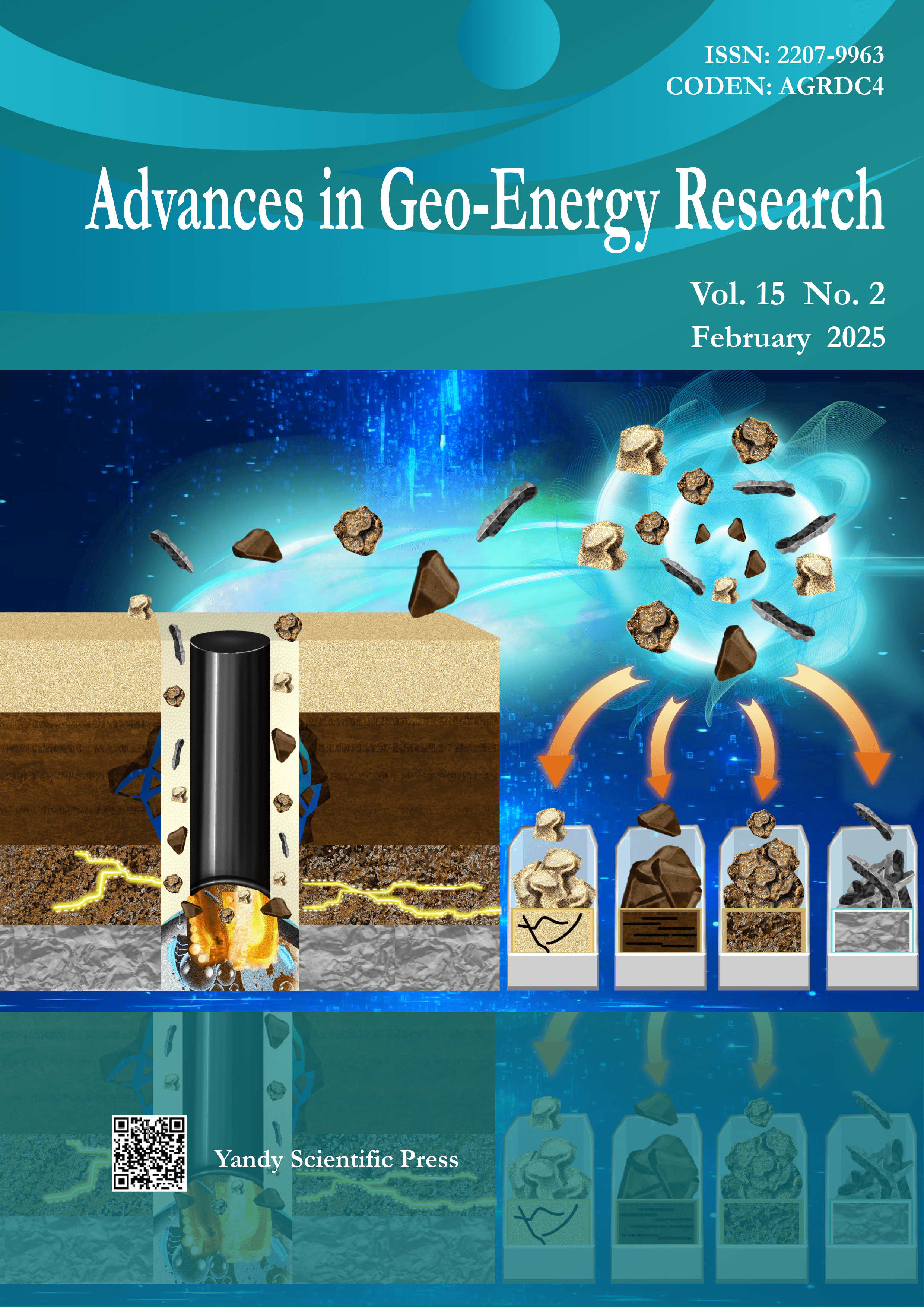Design of passive insulation system and optimization of thermal insulation material for deep in-situ condition-preserved coring
Abstract
In order to help establish a new theory of deep rock mechanics and better guide the development of deep engineering, it is crucial to develop a deep in-situ condition preserved coring device capable of obtaining cores while maintaining their original in-situ temperature and pressure conditions. To achieve insulation functionality within a compact design, a passive insulation system must be developed for such coring devices. Considering the size constraints and thermal insulation requirements, a passive thermal insulation system combining a vacuum layer and an insulating material layer has been designed in this work. Epoxy resin was selected as the insulation material due to its high compressive strength and low thermal conductivity. The type and dosage of curing agents, as well as the curing process with epoxy resin, were optimized. The ideal resin achieved a compressive strength of 241.03 MPa and a thermal conductivity as low as 0.25 W/m·K. Additionally, it exhibited excellent thermal stability and a high decomposition temperature. Under high temperature and high-pressure water conditions simulating deep-earth environments, the epoxy resin’s maximum water absorption was below 0.7%. The insulation layer could effectively minimize heat exchange between the core and the external environment by up to 19.01%. These findings provide a significant contribution to the advancement of passive insulation systems for deep in-situ core drilling operations.
Document Type: Original article
Cited as: Yang, J., Bai, H., He, Z., Yu, B., Xie, H. Design of passive insulation system and optimization of thermal insulation material for deep in-situ condition-preserved coring. Advances in Geo-Energy Research, 2025, 15(2): 99-111. https://doi.org/10.46690/ager.2025.02.03
DOI:
https://doi.org/10.46690/ager.2025.02.03Keywords:
Deep in-situ conditions, coring device, passive insulation system, thermal insulation material, epoxy resinReferences
D’Almeida, J., Monteiro, S. The effect of the resin/hardener ratio on the compressive behavior of an epoxy system. Polymer Testing, 1996, 15(4): 329-339.
Du, U. L. N., Bethke, C., Altstaedt, V., et al. New insights on expandability of pre-cured epoxy using a solid-state CO2-foaming technique. Polymers, 2021, 13(15): 2441-2463.
El Gazzani, S., Nassiet, V., Habas, J.-P., et al. High temperature epoxy foam: Optimization of process parameters. Polymers, 2016, 8(6): 215-233.
Hossain, M. E. Drilling costs estimation for hydrocarbon wells. Journal of Sustainable Energy Engineering, 2015, 3(1): 3-32.
Inada, N., Koji, Y. Data report: Hybrid Pressure Coring System tool review and summary of recovery result from gashydrate related coring in the Nankai Project. Marine & Petroleum Geology, 2015, 66(2): 323-345.
Kong, L., Xie, H., Li, C. Coupled microplane and micromechanics model for describing the damage and plasticity evolution of quasi-brittle material. International Journal of Plasticity, 2023, 162: 103549.
Kumar, A., Srivastava, A. Preparation and mechanical properties of jute fiber reinforced epoxy composites. Industrial Engineering & Management, 2017, 6(234): 2169-0316.
Liang, B., Gao, H., Lan, Y. Theoretical analysis and experimental study on relation between roack permeabikity and temperature. Chinese Journal of Rock Mechanics and Engineering, 2005, 24(12): 2009-2012. (in Chinese)
Lin, S., Huang, Y., Xie, D., et al. Molecular relaxation and glass transition properties of epoxy resin at high temperature. Acta Physica Sinica, 2016, 65(07): 304-310.
Moller, J. C., Berry, R. J., Foster, H. A. On the nature of epoxy resin post-curing. Polymers, 2020, 12(2): 466.
Okabe, T., Oya, Y., Tanabe, K., et al. Molecular dynamics simulation of crosslinked epoxy resins: Curing and mechanical properties. European Polymer Journal, 2016, 80: 78-88.
Saif, T., Lin, Q., Bijeljic, B., et al. Microstructural imaging and characterization of oil shale before and after pyrolysis. Fuel, 2017, 197: 562-574.
Shi, X., Li, J., Li, C., et al. Design and strength analysis of the passive thermal insulation structure of a deep rock in-situ thermal insulation coring system. Thermal Science, 2023, 27(1B): 1-8.
Tao, W. Q. Heat Transfer (The fifth edition). Beijing, P. R. China, Higher Education Press, 2019. (in Chinese)
Thirumalai, R., Prakash, R., Ragunath, R., et al. Experimental investigation of mechanical properties of epoxy based composites. Materials Research Express, 2019, 6(7): 075309.
Vashisth, A., Ashraf, C., Bakis, C. E., et al. Effect of chemical structure on thermo-mechanical properties of epoxy polymers: Comparison of accelerated ReaxFF simulations and experiments. Polymer, 2018, 158: 354-363.
Wang, H., Huang, H., Bi, W., et al. Deep and ultra-deep oil and gas well drilling technologies: Progress and prospect. Natural Gas Industry B, 2022, 9(2): 141-157.
Xie, H., Gao, M., Zhang, R., Zhou, H., et al. Application prospects of deep in-situ condition-preserved coring and testing systems. Advances in Geo-Energy Research, 2024, 14(1): 12-24.
Xie, H., Liu, T., Gao, M., et al. Research on in-situ condition preserved coring and testing systems. Petroleum Science, 2021, 18(6): 1840-1859.
Xue, Y., Wang, J., Xiao, J. Bibliometric analysis and review of mine ventilation literature published between 2010 and 2023. Heliyon, 2024, 10(4): e26133.
Yang, J., Chen, L., Gu, X., et al. Hollow glass micro spheres/silicone rubber composite materials toward materials for high performance deep in-situ temperature-preserved coring. Petroleum Science 2021, 19(1): 309-320.
Zhang, Y., Sun, J., Zhao, H., et al. Test research on in-situ sampler for gas hydrate. Exploration Engineering (Rock & Soil Drilling and Tunneling), 2007, 34(9): 62-65. (in Chinese)
Zhao, J., Yang, D., Kang, Z., et al. A micro-CT study of changes in the internal structure of Daqing and Yan’an oil shales at high temperatures. Oil Shale, 2012, 29(4): 357.
Zhou, X., Pang, X., Li, Q., et al. Advances and problems in hydrocarbon exploration in the Tazhong area, Tarim Basin. Petroleum Science, 2010, 7(2): 164-178.
Zhu, H., Liu, Q., Wong, G., et al. A Pressure and Temperature Preservation System for Gas-hydrate-bearing Sediments Sampler. Petroleum Science and Technology, 2013, 31(6): 652-662.
Downloads
Downloads
Published
How to Cite
Issue
Section
License
Copyright (c) 2024 Author(s)

This work is licensed under a Creative Commons Attribution-NonCommercial-NoDerivatives 4.0 International License.
